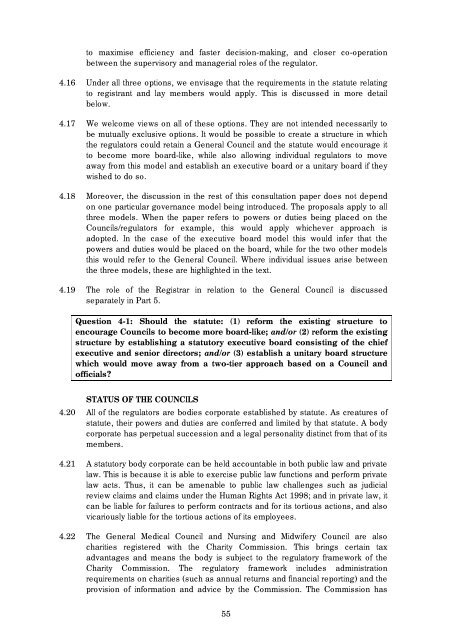Regulation of Health and Social Care Professionals Consultation
Regulation of Health and Social Care Professionals Consultation
Regulation of Health and Social Care Professionals Consultation
You also want an ePaper? Increase the reach of your titles
YUMPU automatically turns print PDFs into web optimized ePapers that Google loves.
to maximise efficiency <strong>and</strong> faster decision-making, <strong>and</strong> closer co-operation<br />
between the supervisory <strong>and</strong> managerial roles <strong>of</strong> the regulator.<br />
4.16 Under all three options, we envisage that the requirements in the statute relating<br />
to registrant <strong>and</strong> lay members would apply. This is discussed in more detail<br />
below.<br />
4.17 We welcome views on all <strong>of</strong> these options. They are not intended necessarily to<br />
be mutually exclusive options. It would be possible to create a structure in which<br />
the regulators could retain a General Council <strong>and</strong> the statute would encourage it<br />
to become more board-like, while also allowing individual regulators to move<br />
away from this model <strong>and</strong> establish an executive board or a unitary board if they<br />
wished to do so.<br />
4.18 Moreover, the discussion in the rest <strong>of</strong> this consultation paper does not depend<br />
on one particular governance model being introduced. The proposals apply to all<br />
three models. When the paper refers to powers or duties being placed on the<br />
Councils/regulators for example, this would apply whichever approach is<br />
adopted. In the case <strong>of</strong> the executive board model this would infer that the<br />
powers <strong>and</strong> duties would be placed on the board, while for the two other models<br />
this would refer to the General Council. Where individual issues arise between<br />
the three models, these are highlighted in the text.<br />
4.19 The role <strong>of</strong> the Registrar in relation to the General Council is discussed<br />
separately in Part 5.<br />
Question 4-1: Should the statute: (1) reform the existing structure to<br />
encourage Councils to become more board-like; <strong>and</strong>/or (2) reform the existing<br />
structure by establishing a statutory executive board consisting <strong>of</strong> the chief<br />
executive <strong>and</strong> senior directors; <strong>and</strong>/or (3) establish a unitary board structure<br />
which would move away from a two-tier approach based on a Council <strong>and</strong><br />
<strong>of</strong>ficials?<br />
STATUS OF THE COUNCILS<br />
4.20 All <strong>of</strong> the regulators are bodies corporate established by statute. As creatures <strong>of</strong><br />
statute, their powers <strong>and</strong> duties are conferred <strong>and</strong> limited by that statute. A body<br />
corporate has perpetual succession <strong>and</strong> a legal personality distinct from that <strong>of</strong> its<br />
members.<br />
4.21 A statutory body corporate can be held accountable in both public law <strong>and</strong> private<br />
law. This is because it is able to exercise public law functions <strong>and</strong> perform private<br />
law acts. Thus, it can be amenable to public law challenges such as judicial<br />
review claims <strong>and</strong> claims under the Human Rights Act 1998; <strong>and</strong> in private law, it<br />
can be liable for failures to perform contracts <strong>and</strong> for its tortious actions, <strong>and</strong> also<br />
vicariously liable for the tortious actions <strong>of</strong> its employees.<br />
4.22 The General Medical Council <strong>and</strong> Nursing <strong>and</strong> Midwifery Council are also<br />
charities registered with the Charity Commission. This brings certain tax<br />
advantages <strong>and</strong> means the body is subject to the regulatory framework <strong>of</strong> the<br />
Charity Commission. The regulatory framework includes administration<br />
requirements on charities (such as annual returns <strong>and</strong> financial reporting) <strong>and</strong> the<br />
provision <strong>of</strong> information <strong>and</strong> advice by the Commission. The Commission has<br />
55
















